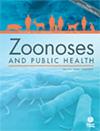Antimicrobial resistance in Escherichia coli isolated from pigs and associations with aggregated antimicrobial usage in Ireland: A herd-level exploration
Abstract
Aims
Antimicrobial resistance (AMR) is of significant global concern and is a major One Health issue. There is evidence to suggest that increased antimicrobial usage (AMU) can be associated with AMR patterns, and therefore, there have been efforts to reduce AMU in anticipation of reducing AMR emergence risk. The aim of this study was to investigate whether there were any associations between AMU and AMR patterns of commensal Escherichia coli isolated from pig herds in Ireland.
Methods and Results
Data on AMR from a panel of antimicrobials (AMDs) were gathered as part of national surveillance activities. These data were associated with reported usage of AMDs, on a year-quarter basis, measured in mg/kg at a herd-level using generalized estimating equation regression analysis. Associations were tested with AMR presence or multi-drug resistance (MDR; ≥3 classes) profiles and total AMU during the contemporaneous quarter and previous quarter, respectively. Furthermore, individual and AMD class-based associations were tested. The final dataset contained 218 observations (herd-quarter usage and AMR resistance profile) from 122 herds during 2019–2021. Apparent resistance prevalence varied according to AMD type, with the highest mean prevalence found with tetracycline at 51.57% (95% CI: 45.06%–58.09%). There were significant associations between a herd obtaining a positive AMR result for any AMDs and the overall levels of AMU during the year-quarter. Furthermore, there were significant positive associations between MDR and total AMU. At the compound level, chloramphenicol resistance was significantly associated with increased usage of trimethoprim/sulfadiazine and chlortetracycline, respectively (p < 0.010). Tetracycline resistance was associated with increased use of chlortetracycline (p = 0.008). At the antimicrobial class level, there was a significant positive relationship between the usage of phenicol and the probability of a resistance for chloramphenicol (p = 0.026) and between the usage of tetracycline and tetracycline resistance probability (p = 0.018).
Conclusions
Our data provide evidence of associations between overall AMU and AMR or MDR risk at the herd-quarter level. There was also evidence of associations between specific AMDs and patterns of resistance. Associations varied depending on whether time lags in usage were modelled or how usage was modelled (e.g. dichotomized or continuous). Associations with rarely used AMDs (e.g. critically important AMDs) were precluded due to a lack of statistical power. Continued monitoring of both AMU and AMR is crucial to assess the impacts of policy changes aimed at reducing AMU.

 求助内容:
求助内容: 应助结果提醒方式:
应助结果提醒方式:


